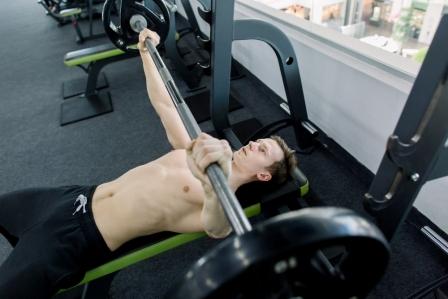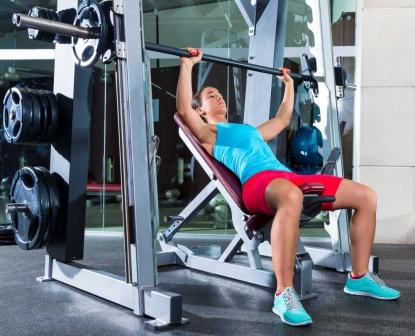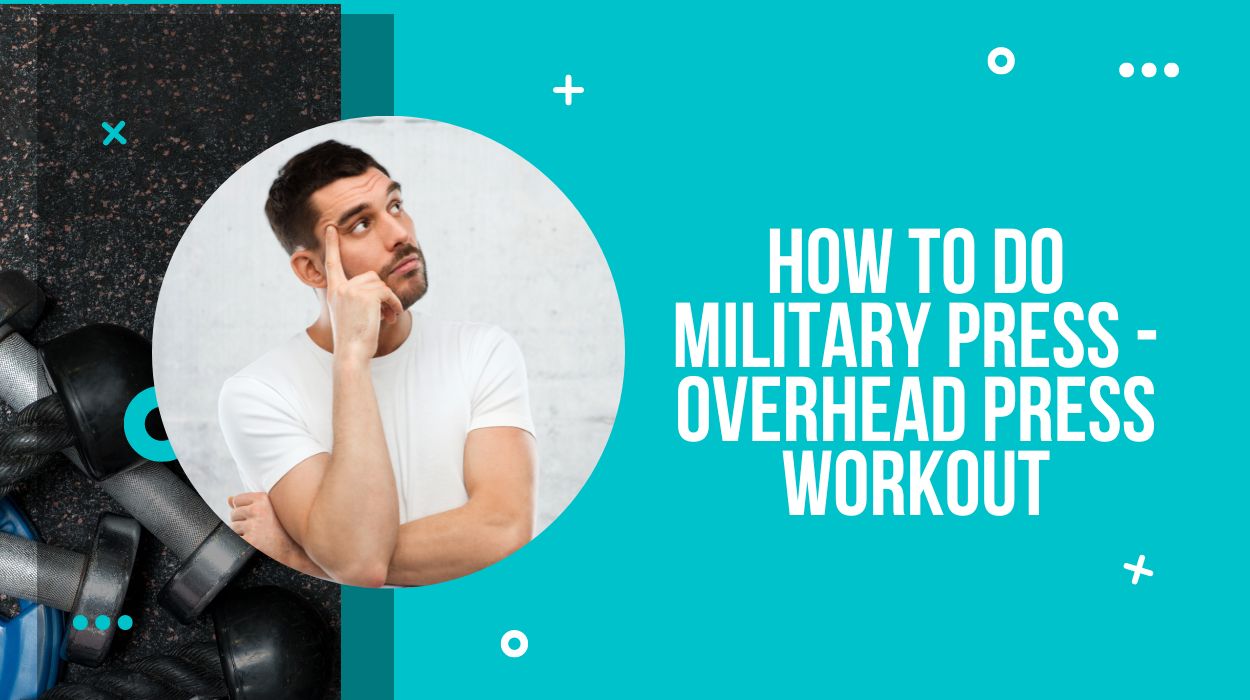The military press is an essential workout exercise known by several names, like overhead press, shoulder press, or just press. But why is it called the military press?
Well, the movement required in this exercise was a crucial indicator in testing the candidates’ strength. It helped in their selection in the military.
Another interesting fact about the military press was that it was one of the lifts in the Olympics till 1972. However, it was removed due to difficulties in the judging procedure.
| Utility | Basic |
| Mechanics | Compound |
| Force | Push |
Muscles Worked by the Military Press:
The military press targets the following muscle groups:
- Deltoids
- Triceps
- Traps
- Upper chest
- Biceps
- Abs
- Glutes
- Serratus anterior
- Latissimus dorsi
- Lower back
Let us look further into this matter.
As you can see, a military press targets all major muscle groups in your upper body. In fact, the only other significant groups remaining untouched due to this exercise are hamstrings, quads, and calves.
Other than that, it also works on the core and legs that help the lifter in stabilizing their weight.
Most of the workload is laid upon the shoulders while performing the military press, including the anterior and medial delts.
Coming to the back, your traps and rhomboids are targets for strengthening your back. Overall, it targets all your core muscles, making it a comprehensive exercise.
According to health experts, when you perform the military press in a seated position, all the work will fall upon the triceps and shoulders. On the other hand, while performing it in a standing position, all the major muscle groups will get activated.
Benefits of Military Press
Now that we know about the muscles targeted by a military press, it is time to move on to its benefits.
The following advantages will prove to you why you must include the military press in your workout routine:
Strong Shoulders

Everybody has a particular body part that they want to work the most on. If the shoulder is that one part for you that feels weak, a military press is for you!
When you perform the shoulder press, the anterior and medial deltoids are targeted. The rear or posterior deltoids are also used, but they are considered to be the stabilizer muscles. Such a variation helps in getting more robust and more defined muscles.
The range of motion involved in a military press is advantageous and healthy for your shoulder girdle. Moreover, when trap muscles and scapula health complement such strong shoulders, you can perform pull-ups in a better way too.
Scientifically speaking, the military press also helps in maintaining scapular-humeral rhythm, also known as glenohumeral rhythm. It helps in shoulder movements like upward and downward rotation, retraction, protection, elevation, etc.
Core Strength

Besides increasing the size and strength of shoulder muscles leading to thick shoulders, it also works on the core strength.
While performing exercises like the military press, your core will get a ripped and beneficial workout. When you try performing it, you will need to stabilize your spine. This will activate your core muscles.
Moreover, a strong core is a prerequisite to avoid a protruded rib cage or arch in the lower back. It can be developed eventually with the military press.
Improved Posture

While performing a standing military press, your entire body gets to work, including your legs and core. This aligns your body to give it a better and healthier posture. If you get the form correct, your back will be straight with arms and shoulders extended. Moreover, the arms will be in an upright position with the barbell/dumbbell above the shoulders.
You make any mistake in this form, and your balance will be lost. Hence, besides working on those shredded shoulder muscles, it also helps in maintaining a proper upright posture.
Note: This will only benefit you if you perform the exercise in a standing position.
Comprehensive Exercise
Are you not a lifter or a bodybuilder? Are you into sports like swimming, basketball, baseball, or football? Well, do not skip the military press as you believe that it is only for hardcore lifters. This is an encyclopedic exercise that benefits athletes as well.
It will work on your core stability by strengthening your core muscles. It bars the hyperextension of the lower back while working on obliques, erectors, and rectus abdominis.
Good for Bench Press

Did you know that the military press can help you bench more?
As we all know, bench press targets upper body muscles like deltoids, pectorals, triceps, biceps, and serratus anterior. Similarly, the military muscle targets the same muscle group.
When both the exercises are inculcated in a workout routine, your back gets strengthened. Furthermore, this helps in enhancing your bench press.
How to Perform the Military Press?
If you want to reap all the aforementioned benefits of a military press, you will have to perform it in the proper manner. Any tweaks in your form or posture, and you could potentially injure yourself.
To make it easier for you, we have formulated an easy step-by-step instruction manual that could help you perform the military press.
As mentioned earlier, you can try this exercise in two manners: standing and in a seated position. Even though we have included the steps for both types, we recommend you go with the standing position. It will help you target all the major muscle groups.
Moreover, we also recommend using a dumbbell instead of a barbell. Dumbbells can help you maintain a neutral position while holding it in front as well as the back. Lastly, it helps in stretching your back muscles for better results.
Standing Military Press

- Hold the barbell with your wrists parallel to your elbows. The elbows must not flare out.
- You can use a spotter or a rack for proper and safe assistance.
- Bring the barbell close to your chest and ensure the wrist position. The fingers must face forward.
- Keep your shoulders back and tight. Do not lean forward. Moreover, keep your core strength tight as well.
- Stand on your heels and push the barbell up above your shoulders. Extend your arm to its full position.
- Inhale and exhale while pushing the barbell all the way up.
- To get a full range of motion, work up your shoulder muscles to extend to your fullest.
- Return to starting position and repeat the process.
Sitting Military Press

- Sit down comfortably with your shoulders and back resting against the exercise machine pad. You can rest your legs on the peg.
- Grab the barbell from the rack with your wrist facing forward. The position of the wrists should be above the elbows.
- Slowly hold the barbell with your arms extend upwards. Engage your shoulder muscles for the correct form.
- After holding it for a second, bring it back towards your chest.
- Keep your head held high so that the barbell does not touch it accidentally.
- If you feel that you are going off balance while holding the barbell up, press your legs harder on your legs.
- Repeat the process. If you feel more arch on your back, you must lower the weights.
If you need to have a visual representation, we have cited the video references at the end of the article. They will help you get a better idea about the form and positions.
Common Mistakes to Avoid While Performing Military Press
When it comes to bodybuilding or working out, a simple mistake can lead to severe injuries. As you deal with heavyweights in the military press, an incorrect form can lead to drastic consequences. To save yourself from such injuries, you must avoid the following mistakes while performing the military press:
Not Pushing it Upward
This might seem insignificant, but we have noticed many lifters, especially the beginners, trying to push the barbell frontwards or backward. This can make you lose your balance in a second.
You must always keep your arms in alignment with your elbows while pushing the barbell up.
Too Much Arch on the Back
A little bit of a back arch is permissible to maintain balance and comfort, but arching your back too much can destroy the purpose of the military press. It will not target your shoulder muscles. Moreover, it can potentially cause injuries and pain in your lower back.
Not Having Full Range of Motion
Your arms must extend all the way to trigger and work on your deltoids. Even while bringing it down, it must touch your chest. In the absence of a full range of motion, the majority of the muscle groups will not be worked upon.
Bending your Legs
If the lifters are unable to lift, they bend their legs at the knees and use it to their benefit to raise the barbell. But this will not work as much on your shoulder muscles.
To gain faster and better results, you must keep your legs wide apart (read: parallel to your shoulders) and straight.
Too Heavy Weights
It is good to challenge yourself but only to an extent beyond which you might find yourself covered in bruises. If you are trying the military press for the first time, it is best to go with your previous weights. You can work yourself up with time and practice.
Sets, Reps, Programming Recommendations for Military Press
According to Iron Mind, beginners can try with two sets of ten reps each. The weights should not be more than 25% of their body weight.
For example, if you weigh 70 kgs or 154 lbs, you must start with 17-18 kgs or 38-40 lbs of weight, respectively.
If you are an experienced lifter, you can try two sets of five reps each with the weight of their choice.
Hold the barbell for one second overhead and three seconds at the end of the last rep of a set.
Moreover, women below the age of thirty must only military press 75% of their entire body weight.
Variations of Military Press
The following are some of the most valuable variations of military press that can help you target your shoulder muscles:
- Barbell Push Press
- Barbell Z Press
- Double Kettlebell Overhead Press
- Shoulder Press with Chains/Bands
- Single Arm Landmine Press
- Deadstop Shoulder Press
- Dumbbell Shoulder Press
- Partial Shoulder Press
- Tempo Shoulder Press
- Thrusters
Safety & Precautions for Military Press
Tips can come in handy, especially if you are performing an exercise for the first time. The following safety and precautionary tips can be useful to you while performing the military press:
- Always engage your core and flex your abs while holding the barbell upwards.
- Go for a full range of motions.
- Keep your wrists parallel to your elbows while holding the barbell. Moreover, keep your arms slightly outside your shoulder range while holding the barbell.
- Maintain a neutral grip.
- Do not bend your legs while performing this exercise.
- Do not over arch your back.
- Keep your head up and do not bend your chin.
- If you are performing seated military press, rest your shoulders and arms against the bench.
- Raise the barbell straight upwards and not in front or back.
- Inhale while bringing the barbell down and exhale while pushing it above you.
- Do not perform this exercise if you have shoulder pain or any such injury.
Alternatives of Military Press
Do you want a more comprehensive workout? The following are some of the best military press alternatives that can help you get your desired shoulder strength and size:
- Seated Dumbbell Shoulder Press
- Arnold Press
- Machine Shoulder Press
- Lateral Raise
- Front Plate Raise
- Javelin Press
- Kneeling-on-bench Overhead Press
- Push Press
- Pike Push Up
- Plank


